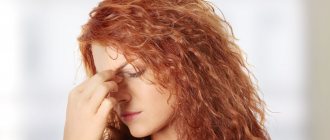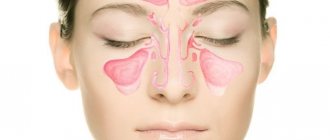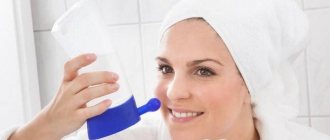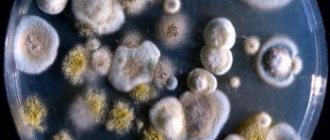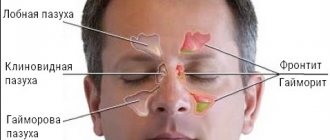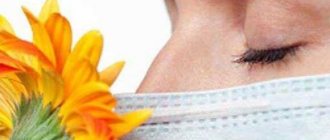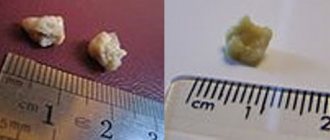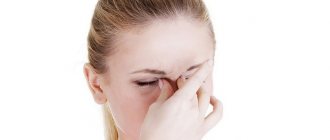Herbs for sinusitis and other sinusitis
Sinusitis is an inflammation of the maxillary or otherwise maxillary sinus.
Sinusitis belongs to a group of inflammatory diseases called sinusitis. Sinusitis is an inflammation of the sinuses. In addition to the maxillary sinus, a person also has one frontal, two ethmoid sinuses and two sinuses of the sphenoid bone. All sinusitis, including sinusitis, can be classified as follows: According to the course of the disease: • Acute • Chronic
By involvement in the inflammatory process: • Unilateral • Bilateral (for those sinuses that have two, for example, frontal sinusitis, that is, inflammation of the frontal sinus cannot be bilateral)
By localization, that is, involvement of the nasal sinuses in the inflammatory process: • Frontitis (inflammation of the frontal sinus) • Sinusitis (inflammation of the maxillary or maxillary sinus) • Ethmoiditis (inflammation of the cells of the ethmoid bone) • Sphenoiditis (inflammation of the sinuses of the sphenoid bone) • Pansinusitis (involvement in the inflammatory process) process of all paranasal sinuses)
In our age of extensive laboratory and instrumental diagnostics, a timely visit to a doctor of any specialty allows us to establish a presumptive diagnosis of sinusitis in the shortest possible time, and then confirm it using X-ray diagnostics.
The prescribed treatment will be aimed at suppressing the growth of pathogenic microflora, relieving edema, and intoxication syndrome.
Can you tell me what place does herbal medicine play in treatment in the presence of a wide arsenal of modern chemical drugs, physiotherapy, surgical treatment and even laser therapy? Herbal medicine, as a method of treatment with a milder effect, in comparison with the effect of modern drug therapy, but longer, can be used in the following cases:
1. For chronic sinusitis (chronic sinusitis among them) 2. For the prevention of exacerbations of chronic sinusitis 3. During the treatment of acute sinusitis with other chemical drugs and/or surgical treatment as an adjuvant therapy
Herbal medicines and their effect on sinusitis
The following are herbal medicines and their therapeutic effects:
1. Anti-inflammatory effect: alanton, infusions, decoctions and tinctures of birch, St. John's wort, calendula, chamomile, coltsfoot, sage, Kuril tea. 2. Removal of intoxication: belosorb, detoxil, superantitox, lignosorb, pecto, polyphepan, recicene-RD, ultrasorb, stimbifide. 3. As a local therapy: alanton, badanoplast, lutenurin, novoimanin, salvin, sangviritrin, “taban-arshan” collection, tinctal, floravit, Rhodiola extract. 4. Restoration of vitamin and mineral metabolism: corfit, infusions and juices of nettle, plantain, oats, cuffs, sea buckthorn juice, holosas. 5. Increasing immunity levels: Irmalax, Ovodarin, Plantaglucide, Ecdisten, Rhodiola extract, Estifan.
Herbs and herbs for sinusitis
What herbs and infusions are used, how to brew, dosage, duration of treatment, when can the course be repeated? The following algorithms for the treatment of sinusitis have been proposed at the Department of Herbal Medicine of RUDN University:
• Collection: Calamus rhizome 10.0 Bergenia rhizome 2.0 Birch buds 15.0 Wintergreen herb 3.0 Calendula flowers 10.0 Tricolor violet herb 15.0 Eucalyptus leaves 10.0 Method of preparation: pour 1 teaspoon of the collection into 200 ml water, leave in a thermos for 30 minutes, take 70 ml warm 3 times a day before meals. Duration of treatment is 2-3 weeks.
• Place cotton swabs in the nasal passages with an aqueous solution of Sangviritrin for 20 minutes, 2 times a day. The course of treatment is 4-6 days.
• Rinse your nose with a saline solution of water or sea water (Dolphin, Solin, Aquamaris) 3 times a day during an exacerbation of the disease for 1-2 weeks and to prevent the disease during the season of colds and ARVI.
• The use of inhalations for sinusitis has proven itself. Inhaling vapors of herbs and essential oils improves nasal breathing, has a local antiseptic effect, and reduces the severity of edema syndrome. For inhalations, both herbal preparations and one type of plant can be used, for example, chamomile, calendula, St. John's wort, eucalyptus, mint, lemon balm, etc., which have an anti-inflammatory effect. Take 1-2 tablespoons of the collection or selected herb, pour in 1 glass of boiling water, infuse for half an hour in a thermos, then inhalation is performed, possibly using a nebulizer. Before inhalation, it is recommended to take 1 glass of herbal tea, especially for children. Inhalation duration is 5 minutes, daily course 6-8 times. You can also use essential oils for inhalation, adding 3-5 drops either to just boiled water or to a solution for inhalation through a nebulizer. You can use clove oil, eucalyptus oil, tea tree, you can add a ready-made mixture of essential oils “Breathe” both for treatment and for the prevention of relapses of the disease during the cold and flu season. At home, you can also add essential oils to an aroma lamp and inhale them before bed. Remember that lower dosages are recommended for children, which are selected depending on the age of the child. An allergic reaction to essential oils is also possible, so it is advisable to perform an allergy test first and start inhalations with minimal dosages (from 1 drop) and with a minimum procedure time, gradually increasing to the recommended dosages and time.
Traditional medicine:
• Drop 2 drops of cyclamen root juice into each nasal passage in the evening for 2-3 days in a row. For children, dilute the juice with water 1:2. • Fill the bottle with chopped horseradish and rosemary herb in a 1:1 ratio. Then fill to the top with wine vinegar, seal and leave in a warm place for 10 days, shaking twice a day. After this period, every hour inhale the contents through the neck for 5 minutes, and in the evening with this tincture make a compress on the forehead and back of the head (10-15 minutes). Carry out a similar procedure until clinical recovery. • Take equal proportions (on average 1 teaspoon) of liquid honey and sea salt and mix. Apply this mixture to the area between the eyebrows (above the frontal sinus) and near the wings of the nose (above the maxillary sinuses). Topical application of this mixture has an anti-inflammatory effect and reduces swelling. Apply 2 times a day, morning and evening, for 10-15 minutes, covering with plastic, then rinse with warm water. At night, you don’t have to rinse it off, but blot it with a napkin. Duration until clinical recovery. • Eat 1 teaspoon of honey with honeycombs 3 times a day 30 minutes before meals for 2 weeks. Take during exacerbation of sinusitis and to prevent relapse of the disease in autumn, winter and spring for 2 weeks. • There is also a folk recipe: “roll” a boiled egg while it is semi-hot in the area of the inflamed sinus until it cools. From the point of view of Western medicine, the therapeutic effect is based on warming up and improving blood circulation. Although, in case of acute purulent sinusitis, I would not recommend any “thermal” procedures, since the inflammation and growth of microflora can only intensify with them!
When using traditional medicine recipes, consult your doctor! Always try to understand what the therapeutic effect is based on and whether this method can be used in your case.
Since there is no treatment suitable for all patients, each of us has our own “features” of the course of the disease, the level of the body’s immune forces. The same disease can occur in different ways!
Inhalation for sinusitis
- Ear, throat, nose
- Sinusitis
- Inhalation for sinusitis
Sinusitis appears as a consequence of a prolonged runny nose or any previous illness. Signs of sinusitis are nasal congestion, inflammation of the paranasal sinuses, accumulation of pus in the sinuses, severe headaches.
When sinusitis is just beginning, a good way to stop it is various inhalations. The basis of these inhalations can be various infusions, decoctions, tinctures of medicinal plants. Bee products and essential oils also help. Inhalation for sinusitis is an effective treatment.
Rules for using inhalation for sinusitis
When treating sinusitis with inhalations, a number of rules should be followed:
- Carry out inhalations for sinusitis for 6-8 days in the morning and evening for five to seven minutes.
- The nose should be thoroughly cleaned before the procedure.
- When using sprays and drops, inhalation should be carried out after half an hour.
- Before starting the procedure, drink tea with the addition of currant leaves or hot infusions of plantain leaves, wild strawberries or St. John's wort (a teaspoon in half a glass of water), which helps the outflow of mucus.
- The steam should be inhaled through the mouth and exhaled through the nose. Only when exhaling does the steam reach the sinuses - this is a physiological mechanism.
- In case of exacerbation of chronic sinusitis or other disease and an increase in body temperature, inhalation is contraindicated.
- Children are allowed to do inhalations for sinusitis.
- Pregnant women should carry out inhalations carefully, using hypoallergenic agents, so as not to harm the baby.
Medicinal herbs for inhalation
For inhalations for sinusitis, it is necessary to use medicinal herbs , which relieve swelling of the mucous membrane, and also dilute and facilitate the discharge of pus from the nose.
- One part St. John's wort herb, two parts chamomile flowers, three parts yarrow herb, one part celandine herb. Pour 2 tablespoons of the mixture into a glass of boiling water, place in a warm place for half an hour, use for steam inhalation for sinusitis .
- Two parts plantain leaves, three parts mint herb (melissa), two parts celandine herb.
- One part eucalyptus leaves, one part calendula flowers, three parts raspberry leaves.
- Three parts black currant leaves, two parts oregano herb, one part hawthorn flowers.
- One part walnut, two parts yarrow herb, three parts plantain leaves. Pour a glass of boiling water and leave for one hour.
- One part marshweed, two parts St. John's wort, one part chamomile. Pour a glass of boiling water and leave for 30 minutes.
- Add 2 drops of mint tincture, 4 drops of eucalyptus tincture to a liter of boiled water, breathe in the steam for five minutes.
- Add a tablespoon of honey to a glass of boiling water and breathe over the glass for 10 minutes.
A popular method of treating sinusitis is nebulizer inhalation . This treatment is effective because the medications are sprayed directly into the nasal passages.
This treatment can be used even for small children, using nebulizers that spray medicine directly into the air, and the child can inhale it while sleeping or playing.
Before starting treatment, a doctor's consultation is necessary.
Source: https://nmedicine.net/ingalyaciya-pri-gajmorite/
Contraindications for treating sinusitis with herbs
Herbal medicine is contraindicated if:
— The patient has allergic reactions to the components of the preparation. — The patient has allergic reactions that occurred during treatment with phytotherapeutic drugs. — As the only therapy for life-threatening conditions, such as acute purulent sinusitis, high fever, severe intoxication syndrome.
Herbal medicine can be used, but with caution:
1. For self-treatment of chronic sinusitis. 2. If the general condition and laboratory test parameters worsen, it may be necessary to include in the treatment chemical drugs that have a faster therapeutic effect. 3. During pregnancy and breastfeeding.
In all these cases, it is advisable to consult with your doctor about the use of herbal medicine!
Cure prognosis
What effect can be achieved in treatment and why is traditional treatment prescribed by a doctor so important? Treatment of sinusitis and any other sinusitis should achieve the following goals:
In case of acute sinusitis: • The fastest possible recovery • Complete clinical recovery • Prevention of the development of complications of sinusitis, in the form of meningitis (inflammation of the meninges), etc. • Preventing the infection from becoming chronic
For chronic sinusitis: • Prevention of relapse of the disease • Anti-inflammatory effect • Removal of edema syndrome • Vitamin therapy • Increased defenses of the body • Improvement of the general condition of the patient
Let me summarize: the principle of treating sinusitis with herbs is the same as for any other disease, that is, we treat the disease in the acute phase with “emergency aid” means - we follow the instructions of the attending physician, undergo a course of therapy with chemical drugs, droppers, injections, tablets and other pills . And if the inflammation does not respond to conservative treatment and it is necessary to evacuate the purulent contents from the sinuses through surgical intervention, then you need to trust the surgeon. At this stage, herbal medicine can only complement the main treatment.
Herbal medicine is becoming more widely used in patients with chronic sinusitis and for the prevention of frequent relapses of the disease.
Healer's pharmacy: herbs for sinusitis
When the maxillary sinuses become inflamed, cold and flu symptoms often appear. Treatment of sinusitis must be comprehensive, which is why doctors recommend combining the use of traditional medications and folk remedies. Of course, it is not recommended to select herbs for sinusitis on your own; you should ask your doctor about their use.
Sinusitis often occurs due to rhinitis, influenza and other less common infectious diseases. Often, to eliminate the disease, they resort to unconventional methods of treatment, for example, using infusions, decoctions and ointments based on medicinal plants.
Treatment with ointments
If you do not follow the initial stages of sinusitis development, then sometimes it is necessary to use more labor-intensive procedures. For example, ointments that are applied to the skin directly above the cavity formation (sinus or sinus) and inside the nasal passage have a great therapeutic effect.
Preparation of aloe ointment
Recipe for aloe ointment: mix one teaspoon each of aloe and kalonchoe juice thoroughly with juice from cyclamen root and Vishnevsky ointment. Soak cotton swabs with the resulting mixture and insert into the nasal passages for 30 minutes. The course of treatment is 20 days.
Recipe for propolis-based ointment (in finished form - preparations from the Tentorium company): mix refined vegetable oil with an equivalent amount of bee propolis. Melt over low heat and let sit for at least 15 minutes until the components are completely dissolved in each other. Before use, the resulting ointment should be heated in order to give it plasticity and activate the main medicinal properties.
A recipe from the Siberian outback during the USSR may seem very interesting. Take vegetable oil, alcohol, honey, bay leaf or thuja leaf, mummy, crushed laundry soap in equal parts. In a water bath, bring all of the above to a homogeneous state (the entire mixture has the same consistency). After cooling, the ointment is ready for use. Can be used for both intranasal (inside the nasal passage) and external applications.
Return to contents
In what cases is herbal medicine justified?
Natural remedies for sinusitis in some cases are the only remedy that helps get rid of annoying pain and constant nasal congestion. They have a gentler effect on the mucous membrane than well-known drugs, however, they effectively eliminate nasal congestion and relieve inflammation.
The use of home medicine is justified in the following cases:
- Chronic course of sinusitis. After eliminating the symptoms of acute inflammation, you need to help the body cope with the residual manifestations of the pathology.
- In acute cases of the disease, it is advisable to combine traditional and non-traditional methods. Such exposure to unrecognized drugs increases the impact of medical drugs.
- For preventive purposes, to strengthen the immune system.
- During the recovery period.
- As a means of auxiliary vitamin therapy.
You should remember the basic rules for using folk remedies:
- Treatment of sinusitis with herbs is a rather lengthy process. You will have to use suitable products for several months, with minor breaks, which are necessary to prevent addiction.
- When using allergenic components, you should be aware of the body's possible reaction. You need to start using small dosages, monitoring the body's reaction.
- Herbs for sinusitis must be used environmentally friendly, because plants growing in polluted areas have a negative effect on the human body.
- If an allergic reaction occurs or if the patient’s well-being worsens, treatment should be stopped.
Patients who decide to treat sinusitis with herbs should remember the need to take precautions.
Sinusitis
Lyudmila
Yulia Evgenievna, sorry for the delay in answering, we had a hurricane and had a very bad headache.
I am simply not able to re-translate the KMT analysis for 2003. I did not repeat this test in Russia because my gastrointestinal tract and back hurt, and I did tests in Russia to find an answer to what was wrong with the gastrointestinal tract and back.
Tests done by a neurologist: MRI OF THE BRAIN, FINDINGS: Nonspecific cerebral white matter hyperintensities are noted bilaterally which are most prominent in the periventricular region in the atrium and left lateral ventricle. Hyperintensity in portion of the mid brain is most likely due to prominent perivascular spaces. Similar prominent perivascular spaces are seen lower basal ganglia. These are variants of normal. (Indeterminate cerebral white matter hyperintensities are present bilaterally, which are most significant in the periventricular area in the atrium and left lateral (horizontal) ventricle. Hyperintensity in the middle lobe is most likely due to significant perivascular spaces. Related prominent perivascular spaces are visible below the bazal gania. These are normal variants.)
Orbits and temporal bones appear normal. Mucoperosteal thickening is seen in the maxillary sinuses, ethmoid air cells and sphenoid sinus. Flow void is seen in the cavernous carotid arteries and vertebral vessels. (Orbits and temporal bones are normal. Mucoperosteal thickening is visible in the maxillary sinuses, ethmoid air cells and sphenoid sinus. Flowing void is visible in the cavernous carotid arteries and vertebrobasilar vessels.)
IMPRESSION: nonspecific cerebral white matter hyperintensities are noted which may represent small vessel change although they are slightly more prominent than typical for age. Clinical correlation is suggested since other etiologies cannot be excluded. Chronic sinusitis. Impression: Vague cerebral white matter hyperintensities are noted, which may represent small vascular changes as they appear slightly more prominent than typical for age. Clinical correlation is suggested, i.e. other etiologies cannot be excluded. Chronic sinusitis.)
MRA OF THE CIRCLE OF WILLIS WITHOUT CONTRAST, FINDINGS: No significant vascular irregularity, stenosis, aneurysm or malformation is noted.
IMPRESSION: no significant abnormality identified. (Conclusion: no major changes).
https://forums.rusmedserv.com/showthread.php?t=11919. This is where I asked my question in 2005.
I'll look for tests in Russia, I don't remember what year. My sister lives in Orel and I go every year to visit her, she is lonely, disabled and absolutely not needed by anyone, now I don’t know when I can go because of the coronavirus.
So I visited our best neurologist in Orel, if I’m not mistaken, he diagnosed me with encephalopathy and prescribed treatment, intravenously and something else, there was simply no way to get treatment with it, you need to live in Russia for at least 2 months, and I I’m coming for 2 weeks, no more, and my husband is American.
I started having headaches after the flu at the age of 26, I had just graduated from the Moscow Higher Technical School. Bauman, I made it. My head hurts worse in the morning, and at night it also hurts a lot when I wake up.
As for hair growth, I have never had it on my chin, it started maybe about 7 years ago, but I’m not sure about the accuracy, maybe a little more. I read a book by a famous doctor and he wrote something about hair, that usually it starts to grow (if it didn’t exist) with processes in the thyroid gland, he gave advice to check the thyroid gland, but all my tests were normal and quite by accident in Russia with an ultrasound arteries and veins found abnormalities in the thyroid gland.
I took depressants here, when they were prescribed, they did not have any effect, not even the slightest.
Thank you very much.
Anti-inflammatory effect of herbs
A huge number of herbs with healing properties have been identified. They help cope with the inflammatory process in various diseases. Some healers say that many plants can rightfully be called real antibiotics . Their chemical composition contains phytoncides, which exhibit antibacterial, antimicrobial, antiseptic and anti-inflammatory properties.
The list of herbs that help overcome sinusitis is as follows:
- St. John's wort;
- swamp cudweed;
- chamomile;
- silver birch;
- calendula;
- lemon balm;
- peppermint;
- plantain leaf;
- yarrow.
The prepared infusions are administered orally and used for inhalation. Decoctions and infusions of herbs can be instilled into the nose, no more than 5 drops in each nostril.
The duration of the inhalation procedure should not exceed 5 minutes. The medicinal solution can also be used to rinse the nasal cavity. It is worth remembering that such therapy cannot be interrupted; treatment must be carried out until complete recovery.
Useful properties of birch
The healing properties of birch have been known since ancient times. It is a low tree with exfoliating bark and blooms in April. Buds, birch sap and young leaves are selected as raw materials for medicinal compositions. Such components have analgesic, diaphoretic, diuretic and anti-inflammatory effects. Young leaves are famous for their antifungal effect, eliminating Giardia and helminths.
For sinusitis, use birch charcoal. The skin above the bridge of the nose should be lubricated with garlic juice and dried, then rub in birch charcoal powder with light massage movements. Leave the paste on your face for about 20-30 minutes. The procedure must be repeated 2 times a day until the symptoms of the disease completely disappear. An infusion of birch leaves and buds for sinusitis is recommended to be taken orally; it has a positive effect on the human body and helps to cope with the disease.
The healing power of St. John's wort
St. John's wort is one of the most famous plants used by the population in everyday life to treat sinusitis. A simple herb can destroy pathogenic microorganisms with the power of a powerful antibiotic.
It is very simple to prepare a medicinal solution. This will require 1 tbsp. l. dry herbs and 200 ml of boiling water. The solution must be infused for 1 hour, then cooled and the procedure for rinsing the nasal passages performed. This manipulation is recommended for chronic sinusitis, when purulent discharge does not form.
To prepare an infusion for oral use, you need to pour 20 g of raw material into 200 ml of hot water. The solution must be taken 3 times a day, 120 ml. Course duration is 12-14 days.
Calendula for sinusitis
Calendula tincture is widely used to eliminate inflammatory diseases such as rhinitis and sinusitis. Phytoncides were found in the chemical composition of calendula, ensuring the high effectiveness of the composition.
To treat sinusitis, not only alcohol tincture is used, but also decoctions. It should be remembered that you need to resort to using products that contain calendula at the first signs of the disease. Rinsing with calendula decoction will help relieve swelling and eliminate the resulting exudate from the nasal cavity.
Multicomponent compositions
To eliminate sinusitis with solutions at home, multicomponent medicinal formulations are used. A decoction of each plant is prepared separately and mixed together immediately before use.
To prepare composition No. 1 you will need:
- marsh cudweed – 10 g;
- chamomile – 10 g;
- St. John's wort – 15 g.
It should be remembered that the solutions must be mixed immediately before instillation.
For sinusitis, you need to pay attention to complex infusions with calendula, which, in addition to this plant, include:
- peppermint;
- coltsfoot;
- field geranium;
- chamomile flowers;
- yarrow.
The raw materials are mixed in equal proportions, poured with boiling water and infused in a dark place for 24 hours. Used to rinse the nose for sinusitis. The manipulation is performed 2 times a day.
Other folk medicines
In addition to herbs, traditional medicine recipes include many non-traditional methods of treatment.
Bee products: propolis, honey and wax
Apitherapy (treatment with honey and other products produced by bees) is used for purulent inflammation of the maxillary sinuses.
Honey has a bactericidal effect and reduces the symptoms of the disease. It is used to rinse the nose, make honey applications, and apply it internally.
Wax is also actively used to treat sinusitis because it contains antibacterial components and many useful substances. It is used to prepare healing ointments, make applications (form a cake with a diameter of 4-5 cm and apply it to the inflamed area, cover with a warm cloth and hold for 30 minutes). 1 cake can be used 5-6 times. To get a good effect, you need to do 12-15 procedures in 1 day.
Propolis is used in the form of alcohol tinctures, on the basis of which lotions are made. Inhalations with the addition of this substance will help cure sinusitis without the use of medications. The procedure is performed 3-4 times a day.
Herbal tinctures
For sinusitis, tinctures are actively used. Popular recipe: 2 tbsp. St. John's wort or yarrow pour 1 cup of boiling water and simmer in a water bath for 10-15 minutes, you can add 1 tbsp. eucalyptus leaves. Cool the product and strain. Take 2-3 times a day, 0.5 cups.
For tinctures you can take calendula, sage, chamomile. The components found in the plants relieve inflammation and swelling of the nasal cavity, remove mucus and improve the patient’s well-being.
Essential oils
For sinusitis, essential oils of fir, sea buckthorn, tea tree, etc. are used. They relieve swelling, reduce headaches and make breathing easier. Esters improve the discharge of secretions from the sinuses, help moisturize the mucous membrane and heal damaged tissue. Lotions are made with oils, added to solutions for inhalation, and nasal drops are prepared.
Radish
Black radish is a good addition to the main treatment because it contains many vitamins and minerals that will help you cope with the disease faster. It can be classified as a natural antibiotic; it is used as an analgesic, because It relieves headaches that often occur with sinusitis. The presence of flavonoids allows you to speed up metabolic processes at the cellular level and quickly remove toxins - the result of the activity of pathogenic microorganisms.
Compresses are made from radish, a few drops of freshly squeezed juice are instilled into each nostril, and cakes are made from grated root vegetables mixed with honey and other healing ingredients and applied to the area of the maxillary sinuses for a while.
Advice from traditional healers
Treatment of sinusitis with herbs is justified. Many plants have a positive effect on the human body, help cope with pathology and strengthen the immune system. Traditional healers recommend not only rinsing your nose with herbal solutions for sinusitis, but also using steam from certain formulations for inhalation.
To prepare the collection for inhalation you will need:
- peppermint – 1 tbsp. l.;
- lemon balm - 1 tbsp. l.;
- perforated plantain - 2 tbsp. l.
A similar mixture should be poured into 500 ml of boiling water, left for 20-30 minutes, and then boiled. Add 2 drops of eucalyptus essential oil to the mixture. The duration of the inhalation procedure should not exceed 5 minutes.
To eliminate the manifestations and completely defeat the disease, healers recommend using aloe for sinusitis. Everyone has heard about the healing properties of this plant. It is interesting to know that the extract of this plant is included in medications for sinusitis. Healers recommend instilling 5 drops of aloe juice into each nostril 3 times a day. It should be remembered that only the leaves of adult plants have medicinal properties.
Among the most effective herbs for sinusitis, I highlight chamomile and celandine. They should be used as follows:
- Chamomile decoction is simply brewed as tea and the nasal cavity is washed with it. The product helps eliminate tightness of the mucous membranes, relieves irritation, and has an anti-inflammatory effect.
- Rinsing with water with celandine and salt will help get rid of inflammation of the maxillary paranasal sinuses, make mucus more liquid, increase its outflow and increase vascular tone. To prepare 0.5 liters of solution you will need 1 tsp. celandine juice and 0.5 tsp. salt.
It should be remembered that herbal medicine cannot be the main means of treating acute inflammation. Nasal rinsing and inhalation are contraindicated when the temperature rises significantly. The described methods should not be used to treat sinusitis in children.
Treatment of sinusitis at home
Procedures for the treatment of sinusitis are best carried out several times a day in a certain sequence:
- Nasal rinsing.
- Inhalations.
- Instillation of drops.
- And after 5-7 minutes, rinse again. After each stage, you can free the nose from pus; the faster and more pus begins to come out, the better.
- If it is not possible to do a full inhalation during working hours, you can drop essential oil into a glass of boiling water and breathe over it, and then empty your nose and drip the drops.
And remember, the sooner treatment begins and the more often procedures are carried out in the first 3 days, the faster the exacerbation will pass. But treatment should be continued for at least 1-2 weeks.
Contraindications
Herbal treatment is contraindicated in the following cases:
- individual sensitivity of the patient to the components of the fees;
- for diseases that threaten the patient’s life;
- with a significant increase in body temperature (fever);
- the described methods should not be used to treat sinusitis in pregnant and nursing mothers;
- with a purulent inflammatory process.
It is important to remember that any traditional medicine can only be used with the permission of the attending physician. Self-intervention can cause irreparable harm to the human body.
Recommendations for the use of folk remedies
When starting complex treatment, you should not forget about the recommended duration of treatment. To obtain and consolidate the positive effect, a long period of using herbs is necessary. You must use the chosen product for at least several months.
Before starting a long course, you should test the herbal mixture. At the first sign of an allergy, the product should be replaced.
Herbs collected independently should grow in an ecologically clean area, away from roads. Otherwise, they may contain heavy metals and provoke a negative reaction in the body.
IMPORTANT! Before you start taking herbs, you should consult a specialist and strictly follow the regimen and period of consumption.
Herbs for sinusitis - features of use and popular recipes
Considering the availability of a large number of modern drugs, primarily antibiotics, as well as the availability of medical care, people with sinusitis are increasingly turning to treatment with traditional methods. However, treatment of sinusitis with herbs is still popular, especially at the initial stage of the disease or when the course of the disease is uncomplicated. Herbs for sinusitis are much safer than pharmacological drugs and have less negative impact on all systems of the human body.
The content of the article
Features of sinusitis herbal therapy
For sinusitis, herbal treatment is supportive in relation to drug therapy and is mainly aimed at the following purposes:
- reduction of general intoxication of the body, which is a consequence of the presence of an inflammatory process;
- increasing the effectiveness of traditional treatment with chemicals, as well as reducing the severity of side effects from them;
- removal of local manifestations of inflammation;
- increasing general and local immunity;
- prevention of relapse of the disease, especially for chronic sinusitis;
- replenishing the patient’s body with the necessary amount of vitamins that promote recovery;
- improving the patient’s overall well-being and improving his quality of life.
Herbal medicine has a softer and more gentle effect, so it can be used for a long time without much harm to the patient, which is inaccessible to most, even the most modern medicines. Most often, herbs for sinusitis are used in the following cases:
- Long-term treatment of chronic sinusitis during remission.
- Prevention of frequent exacerbations of sluggish sinusitis.
- Auxiliary therapy for conservative or surgical treatment of maxillary sinusitis in acute or purulent form.
The use of all folk recipes is best coordinated with the attending otolaryngologist, so as not to cause harm. It is necessary to pay attention to the possibility of simultaneous use of chemicals and medicinal herbs, as well as individual intolerance to a particular plant.
Traditional medicines based on medicinal plants can be taken in different ways. For this purpose, inhalations, nasal drops, oral infusions, rinses and compresses are used.
Medicinal plants for inhalation
Inhaling the vapors of medicinal plants allows you to direct their beneficial properties directly to the site of inflammation.
This helps reduce tissue swelling, thin mucous accumulations, improve the outflow of exudate from the sinuses, and restore nasal breathing. Inhalations can be carried out using the usual steam method or using a special Nebulizer device.
It is not recommended to use solutions prepared from plants at home in the Nebulizer, since large suspended particles can damage the device.
However, alcohol tinctures of biologically active plants, which are sold in pharmacies, are well suited for this type of aerosol treatment:
- Malavit. Dietary supplement based on a number of minerals and plants (birch and pine buds, thyme, calamus, chamomile, immortelle, sage, peony, celandine, plantain). Has antibacterial, analgesic and antiseptic effects. Mixed with physiological solution in a ratio of 1:30. Inhale three times a day, 3 ml.
- Rotokan. An alcohol infusion of calendula, chamomile and yarrow with a good anti-inflammatory effect. Diluted with sodium chloride 1:40, about 4 ml of solution is inhaled. A solution of alcoholic calendula is used in the same way.
- Eucalyptus. Relieves inflammation in the upper respiratory tract. 15 drops of alcohol tincture are added to a glass of saline solution, inhalation is carried out three times a day, 3 ml. Contraindicated in case of bronchial asthma and other problems with the bronchi.
- Sinupret. Herbal medicine based on gentian root, verbena, elderberry and primrose. It has a mucolytic and anti-edematous effect, increases immunity, and helps cleanse the maxillary cavities of stagnant exudate. The aerosol is inhaled three times a day. Diluted with saline depending on the age of the patient: 1:3 – up to 6 years, 1:2 – up to 16 years, 1:1 – for adults.
However, the Nebulizer is quite expensive, so it is more often used in medical institutions. The majority of the population prefers to treat sinusitis with a proven method - steam inhalation. When preparing them, you can use dried plant materials.
Here are some common recipes:
Mix 10 g of plantain leaves, 5 g of yarrow and immortelle flowers. 2 tablespoons of this mixture are poured into a glass of boiling water, infused for an hour and filtered. For one inhalation, half of the resulting infusion is enough.- 15 g of chamomile flowers, 10 g of calendula flowers and 5 g of meadow geranium herb are infused for 1 hour in 200 ml of boiling water. After filtering, it is used for inhalation; 50 ml is enough for one procedure.
- 15 g of plantain leaves, 10 g of yarrow and 5 g of walnut leaves are brewed and used in the same way as the previous recipe.
In addition to the preparations, you can breathe steam with decoctions of individual herbs, such as St. John's wort, lemon balm, mint, chamomile, and calendula.
They are prepared according to a recipe similar to the preparations: per glass of boiling water, 1-2 tablespoons of dried crushed raw materials; they can be used after half an hour to an hour. As a rule, they breathe for 5 minutes daily, the entire course takes about one week. To enhance the effect, experts recommend that children and adults drink a cup of herbal tea before starting the procedure.
Essential oils (tea tree, eucalyptus, clove, pine), which have bactericidal and anti-inflammatory properties, are often used for steam inhalations. For inhalation, 4-5 drops added to boiling water are enough; for children, the dose is selected individually, starting with 1 drop of oil, since allergic reactions are possible.
"Sinufitol" - a special collection for the treatment of sinusitis
In addition to single remedies, for sinusitis, herbal preparations that combine several plants with different mechanisms of action are effective. In particular, to improve the condition and boost the immune system, they use a special herbal tea “Sinufitol”, which is in the product range.
Herbal tea must be taken orally and instilled into the nose at the same time.
“Sinufitol” helps to cope with swelling and congestion of the nasal sinuses, relieve the condition and prevent the development of sinusitis thanks to six useful plants.
- Primrose . Helps thin mucus and clear it from the nasal passages and sinuses, relieves inflammation, and has an antibacterial effect.
- St. John's wort . One of the most famous natural antibiotics. And in case of sinusitis, the fight against pathogenic microorganisms is the key to effective treatment.
- Initial letter. Helps effectively clear mucus from the maxillary sinuses. This plant also has anti-inflammatory properties.
- Sage. Due to the high content of essential oils, tannins and phytoncides, this collection is responsible for disinfection. Also improves immunity.
- Eucalyptus . Like sage, it exhibits strong bactericidal properties. Essential oils contained in eucalyptus leaves can destroy staphylococci, streptococci and other bacteria. In addition, they thin out mucus and clear the nasal passages.
- Linden flowers . Helps cleanse the maxillary sinuses. At the same time, they relieve swelling and inflammation and help get rid of pain.
To take Sinufitol, you should not wait for signs of acute and chronic sinusitis: doctors prescribe it already for ARVI in order to prevent complications in the form of inflammation.
The use of herbal tea complies with the treatment standards published in 2020 in the new Ukrainian clinical protocol “Acute rhinosinusitis”, which does not recommend the use of antiviral, antihistamine, and expectorant drugs. In this regard, many specialists use herbal medicine methods, prescribing herbal infusions containing anti-inflammatory, decongestant, and analgesic components [ we quote from the medical newspaper “Health of Ukraine” No. 1 (42), February 2020, p. 17 (thematic issue “Pulmonology. Allergology. Rhinolaryngology”)] .
Nasal drops based on herbal ingredients and oral infusions
In terms of their effect, instillations are similar to inhalations, but require less time and effort to carry out manipulations. The amount of active substance in drops is usually higher than in an aerosol, and it does not lose part of its healing properties when exposed to high temperature:
- A collection is being prepared from 2 parts plantain, 1 part lemon balm and 1 part peppermint. 20 g of the collection are poured into a liter of boiling water and infused for 15 minutes. Then add a few drops of essential eucalyptus oil. Drop into the nose 2-3 times for 5 days.
- The juice of pinnate callanchoe is injected into the nose, 3 drops at a time. The result is a strong sneezing, due to which mucus is actively removed from the nasal cavity.
- Mix the juice from the thick lower leaves of aloe with an equal amount of honey, add a couple of drops of celandine. Drip three times a day without swallowing, as celandine can have a bad effect on the stomach.
Cyclamen. Use with caution due to the poisonous sap of the plant root in high concentrations. The juice squeezed from the ground cyclamen forest root is diluted with boiled water (1:4 or 1:8 depending on the patient’s perception) and instilled into the patient lying on his back, 2-3 drops in each nostril. After a short time, active discharge of secretions and sneezing begins. Possible side effects: increased sweating and increased body temperature. If a positive effect is noticeable after the first procedure, it can be repeated after a couple of days.- Mix together equal parts of celandine, aloe juice and bee honey. Inject 10-12 drops into each nasal passage up to 5 times a day. It is not advisable to swallow the mixture. Has a positive effect in the chronic form of the disease.
- 1 tablespoon of the initial medicinal herb should be poured into 0.5 liters of boiling water and then infused for 2 hours. Drip 5 times a day into each nostril.
Often traditional healers offer complex therapy: take the prepared remedy orally and bury it in the nose. This allows you to use the beneficial properties of plants, both at the general and local level.
Well-known recipes in this area are used according to the following scheme: half a glass is drunk three times a day, instillation is also carried out three times a day, 1-2 drops. The general course of treatment is approximately 1 month.
- The crushed components of sandy immortelle flowers, plantain leaves and yarrow stems are brought together in equal proportions. 2 tablespoons of the prepared mixture are poured into 500 ml of boiling water, infused for at least 6 hours and filtered.
- Prepare a collection of coltsfoot, calendula, yarrow, peppermint and bird cherry flowers, leave and strain thoroughly.
- Steam 2 tablespoons of a plant mixture made up of equal parts of stinging nettle leaves, St. John's wort and viburnum bark in a thermos with the addition of 0.5 liters of boiling water. It is necessary to insist all night. After straining, the product is ready for use.
- Mix 2 parts of sage, St. John's wort, chamomile, eucalyptus and lavender with 1 part of yarrow and string in a glass or enamel bowl. Pour 2 liters of boiling water and leave for half an hour. After straining, drink half a glass of infusion every 3 hours.
Grate the washed and peeled horseradish roots on a fine grater. Mix 50 g of the resulting mass with juice squeezed from 3 lemons. Take half a teaspoon half an hour after breakfast. It helps well in case of a chronic disease and prevents its exacerbations. The course of treatment is long (about 3 months), it can be repeated after a break of 1-2 weeks.- Mix 20 g of calendula flowers and St. John's wort with 10 g of poplar buds. Infuse for 2 hours in half a liter of boiling water. Drink 100-120 ml of warm drink before meals. You can add a little honey to improve the taste.
The sinuses of the nose perform a barofunction, that is, they serve to equalize the pressure between the cavity formations of the skull and the atmospheric pressure. For this purpose, they have special communication passages with the nasal cavity, tympanic cavity, etc.
In each of them, inflammation can develop and then the disease becomes called frontal sinusitis, sinusitis, ethmoiditis and sphenoiditis, respectively. When the disease affects all the sinuses at once, they speak of pansinusitis.
When it comes to disease of the paired sinuses (as, for example, in our case), we can talk about unilateral or bilateral damage .
Sinusitis can be acute or chronic.
Acute sinusitis is caused by acute runny nose, scarlet fever, influenza, measles, and acute respiratory viral infections. In addition, diseases of the roots of the four posterior upper teeth play an important role.
Chronic sinusitis develops over time in individuals with frequent recurrence of acute inflammation, against the background of a chronic runny nose, due to a curvature of the nasal septum, congenital narrowness of the nasal passages.
In addition to infectious sinusitis (viral, bacterial, fungal), there is also a vasomotor variant , which develops due to dysfunction of vasomotors, as well as allergic sinusitis , the cause of which is inhaled, less commonly consumed with food or injected substances.
an exudative variant is distinguished (the formation of pus predominates) and a productive variant (the formation of polyps and other growths of the mucous membrane inside the sinus).
Due to the very aggressive course of the infection, tissue necrosis in the sinus may occur. Then they talk about necrotic sinusitis .
As a result of a long chronic course, atrophy of the sinus mucosa often occurs. In this case, they talk about atrophic sinusitis.
Symptoms of acute sinusitis are sensations of tension or pain in the zygomatic areas. The pain is often intense, pressing and tearing in nature. A characteristic feature of the pain is that it intensifies when bending forward (a symptom of tying shoelaces).
The pain may intensify with palpation of the zygomatic areas.
In addition to pain, disturbances in nasal breathing, nasal congestion, impaired sense of smell (anosmia), runny nose, and nasal discharge are often purulent in nature (green or yellow). With the allergic and vasomotor variants of sinusitis, the discharge from the nose is white and transparent, like water.
Sometimes swelling of the cheeks and eyelids on the affected side occurs.
In addition to local specific symptoms, a general toxic syndrome is also observed: increased body temperature, chills, malaise, weakness, decreased performance, sleep and appetite disorders.
In the case of chronic sinusitis, in addition to the already listed symptoms, which appear to a lesser degree during exacerbations, dry mouth in the morning, cracked skin in the corners of the mouth and nose, bad breath, and expectoration of sputum in the morning are also characteristic.
Of course, for the diagnosis, in addition to complaints and symptoms, data from a medical examination, X-ray examination of the maxillary sinuses, clinical tests, and more are taken into account.
For therapeutic purposes, a variety of steps are taken from prescribing medications orally and in the form of irrigation of the middle nasal passage to puncture of the sinuses and surgery on them. Since surgical manipulations are not the topic of our conversation, we will not touch upon them.
Regarding conservative herbal therapy used for sinusitis, it must be said that it is divided into local measures and oral medications.
Local measures are aimed at overcoming the infection, eliminating inflammation in the nasal mucosa and maxillary sinus, removing swelling of the mucous membrane and restoring good communication between the sinus and the nasal cavity to improve the outflow of purulent exudate from the sinus.
In addition, some herbal substances introduced into the nose can increase the resistance of the mucous membrane to infections, which will stop the recurrence of chronic sinusitis.
An anti-inflammatory and antibacterial effect is created by herbs such as wild rosemary, saussurea willow, calendula officinalis, sage, thyme, blue cornflower, chamomile, St. John's wort, bergenia and others.
Usually, a decoction of various parts of these plants is prepared and the nasal passages are washed with it.
Fresh onion juice is used, which is instilled 3-4 drops into each nostril. Onions are especially useful for viral infections.
To eliminate chronic, low-grade inflammation, as well as for allergic sinusitis, plants that can affect local immunity are used.
For this purpose, use fresh aloe juice, fresh juice of Kalanchoe pinnate, squeezed from plant leaves on the day of use.
An interesting effect of Kalanchoe is manifested in prolonged sneezing when only 3-4 drops are instilled into each nostril.
Fresh celandine juice is also used fresh, 2-3 drops in each nostril. Please note that celandine juice, obtained by passing a fresh plant through a meat grinder, is very hot. Therefore, depending on individual sensitivity, the juice can be diluted with clean water.
I would like to draw your attention to the fact that the method with fresh celandine juice is especially indicated for patients who have polyps in the nasal passages, as well as those suffering from a productive version of sinusitis. For polyps, indau, steppe (poisonous!), whitefly, bedbug, lumbago (poisonous! Effective for fungal infections of the mucous membranes of the nose and sinuses), duckweed, euphorbia (poisonous!) are also used.
An interesting recipe for treating sinusitis, proposed by doctor Z.S. Shengelia.
Take fresh cyclamen roots or tubers and grind to obtain juice. Place 2 drops into each nostril. They do this only once.
After introducing cyclamen juice into the nostrils, a pronounced reaction is observed in the form of sneezing, coughing, a feeling of heat throughout the body, and the appearance of sweat on the body and face. You need to calmly endure this reaction, lying in bed with your head tied.
After some time, copious yellow discharge from the nose will appear, which will last for about a day. After which the patient calmly falls asleep and sleeps for about a day.
It is believed that this method is best used under the supervision of a doctor.
As a worthy alternative, especially for those who are not very friendly with raw plants, there is a ready-made cyclamen preparation for topical use - Sinuforte. This is a spray that contains extract and juice of cyclamen tubers. Research regarding Sinuforte has helped in understanding how cyclamen works. It turned out that due to saponins, an antimicrobial, immunomodulatory and reflex decongestant effect develops.
In the form of decoctions, horsetail (herb), elecampane (root), tripartite string (herb), wild strawberry (herb), marsh rosemary (shoots), ivy bud (herb), angustifolia fireweed (herb) are used.
Washing should be done regularly and quite often, at least 3-5 times a day.
I would like to draw your attention to the high importance of actively removing pus from the sinuses.
To do this, you can use (except for the described recipes with cyclamen and celandine) rinsing the nasal passages with a hypertonic solution of table salt. Take 1 tablespoon of salt per glass of boiled water. Washing is done with a warm solution 2-3 times a day.
Internal treatment in the acute period is aimed at reducing inflammation and eliminating intoxication.
For this purpose, decoctions of anti-inflammatory herbs are prescribed, such as meadowsweet, willow bark, Ural licorice, and raspberries.
At the same time, give a lot of liquid to drink, preferably with a high content of vitamin C: rose hip decoction, cranberry or lingonberry juice, viburnum or rowan jelly.
The removal of fluid is activated by diuretic and diaphoretic herbs. The first include horsetail, tansy, wheatgrass, juniper, polpal, lingonberry, bearberry, ivy bud and others. Diaphoretics: cordate linden, black elderberry, tripartite string, common raspberry.
For the treatment of chronic sinusitis, immunomodulators are of particular importance. They can be given both during the period of exacerbation and the period of remission. During an exacerbation, you can take, for example, Echinacea purpurea (flowers).
For basic immunotherapy, it is good to use tinctures of the roots of Rhodiola rosea, Eleutherococcus senticosus, Fischer's milkweed, Leuzea safroliformes, and Aralia Manchurian during the period of remission. It is important to note that the use of such immunomodulators during an exacerbation is undesirable.
In conclusion, one of the exotic recipes of Kalmyk folk medicine.
A patient with sinusitis is taken to a steam bath.
Hair moistened with water is combed into a parting on one side of the head. A green hellebore leaf rolled into a tube is placed on the scalp that has opened in the parting.
Then they comb the hair a little further, and again place the hellebore in the parting.
This is done several times. Then the head is wrapped in a linen cap, and the patient is sent to the steam room.
After visiting the steam room, approximately the same thing happens to the patient as when instilling cyclamen juice (see above) - copious purulent discharge from the nose, fever, even some narcotic effect. The patient should be warmly wrapped in bed.
After a day, as the mucus from the nose subsides, the condition returns to normal.
Many thanks to one of my patients who told me this recipe from his own life.
However, given the amazing toxicity of green hellebore, I strongly do not recommend using such methods to my readers.
Compresses with herbal remedies for sinusitis and nasal rinsing
For the treatment of sinusitis in the initial stage, phytoapplications, which have a vasodilator, analgesic, anti-inflammatory and antiseptic effect, are very helpful. Compresses can be external or introduced directly into the nose using turundas.
- Place rosemary and finely chopped horseradish root in equal proportions into a glass bottle, fill to the top with wine vinegar and cap tightly. Shaking regularly, leave in a warm place for 10 days. Make a compress on the back of the head and forehead with the mixture from the bottle for up to 15 minutes, and also inhale the contents directly from the neck for 5 minutes.
- Prepare a decoction of bay leaves (bring 10-20 g of bay leaves to a boil and cool). A napkin is moistened in the resulting warm liquid and placed on the face in the projection of the paranasal sinuses. To make the compress cool more slowly, it is better to cover your face with a linen napkin or towel. After the napkin has cooled, it is wetted again. The procedure is repeated several times.
- Cotton swabs are moistened with an aqueous solution of Sangrivitrin (a mixture of the herb Macleaia small-fruited and Macleaia cordata) and placed in the nose for 20 minutes twice a day. Repeat the procedure for a week.
Prepare a multi-component mixture of 3 parts of black currant leaves, 2.5 parts of cucumber, chamomile, lungwort, calendula, 2 parts of juniper needles, horsetail, mallow and blackberry leaves, 1.5 parts of thyme, elecampane, wormwood, mullein and sweet clover. All this is mixed and poured with boiling water for 40 minutes, then filtered through a colander and lightly squeezed. A warm (about 40 degrees) wet mixture is laid out on the face, previously cleaned of fat, in the area of the air cavities and nose, and covered with a towel or scarf to preserve heat. The compress lasts for half an hour, after which it is not recommended to go outside. This phytoapplication is carried out every other day or daily, preferably before bedtime.
Plant decoctions are widely used for nasal rinsing. In addition to the direct function of liquefying and evacuating mucus, they have a wound-healing, regenerating, anti-inflammatory and decongestant effect. Decoctions of chamomile (a teaspoon per glass of hot water) and a solution of table salt with a decoction of celandine (0.5 teaspoon of salt and 1 teaspoon of celandine) have proven themselves to be very effective.
Contraindications and features of the use of herbal remedies for sinusitis
Before using any herbal preparations, you need to carefully study the features of their effect on the human body. Herbal medicine is contraindicated in the following cases:
- Individual intolerance to individual components of the medicinal collection.
- Development of allergic reactions after the start of therapy using plant materials.
- Deterioration of the patient’s general condition or deviations in laboratory tests due to herbal medicine. In these cases, you should be further examined and the treatment regimen should be adjusted, if necessary, changing natural drugs to pharmacological ones with a more pronounced effect.
For pregnant and lactating women, infusions and decoctions of herbs can be used only with the permission of a doctor and only if the benefits of their use exceed the harm from possible side effects. You cannot rely only on natural components if the disease is in the acute phase, with purulent discharge and severe symptoms. In case of chronic sinusitis, it is necessary to monitor the dynamics of the patient's condition during treatment with herbal remedies and make changes to therapy.
Sources:
https://medicalj.ru/maneuver/fitoterapiya/1211-travy-pri-gaimorite https://gaimorit-sl.ru/narodnoe/travy-ot-gaimorita.html https://lorcabinet.ru/verhnechelyustnoy-sinusit/ terapiya/travy-ot-gajmorita.html
Contraindications and possible negative consequences
You should begin self-treatment with herbs only after consultation with a specialist. You should first carefully study the properties and characteristics of each selected plant. The use of herbal medicine is prohibited in the following cases:
- Individual intolerance to components in a folk recipe.
- The occurrence of allergic reactions to a natural product.
- General deterioration of the patient's well-being.
- Changes in test results for the worse due to herbal consumption.
Particular attention should be paid to pregnant women. Traditional methods can be used only if there is no negative impact on the health of the fetus.
In case of acute illness, it is impossible to treat only with herbal medicine. Complex treatment is required together with medications or surgery, if necessary.
Treatment of a chronic disease requires close attention. In the absence of positive dynamics, it is necessary to make timely changes to the therapy.
source
